Behavior of Corrosion-Repaired Concrete Beams Reinforced by Epoxy Mortar
2016-09-06WuJinTangJinzhiLiHongmingShangBaokangWangZhe
Wu Jin, Tang Jinzhi, Li Hongming, Shang Baokang, Wang Zhe
Department of Civil Engineering, Nanjing University of Aeronautics and Astronautics, Nanjing 210016, P.R. China
(Received 5 May 2015; revised 30 May 2015; accepted 9 June 2015)
Behavior of Corrosion-Repaired Concrete Beams Reinforced by Epoxy Mortar
Wu Jin*, Tang Jinzhi, Li Hongming, Shang Baokang, Wang Zhe
Department of Civil Engineering, Nanjing University of Aeronautics and Astronautics, Nanjing 210016, P.R. China
(Received 5 May 2015; revised 30 May 2015; accepted 9 June 2015)
The performance of concrete beams repaired with epoxy mortar was investigated by constructing twelve beam specimens. All the beam specimens were subjected to a constant current for accelerated corrosion. Six specimens were corroded without subsequent reparation as a control group, and the other six beam specimens were corroded and repaired utilizing epoxy mortar. All specimens were tested to failure. During test process, we focused on the failure pattern of beam specimens, structural cracks, mid-deflections, bearing capacity, and probed into the influence of corrosion degree and repair of epoxy mortar on the performance of beam specimens. It was observed that corrosion-repaired beams in the loading test were in a bending failure pattern. It is obvious that cracking loads and bending stiffness of repaired beams and corrosion-repaired beams were larger than those of unrepaired beams and secondly-corroded beams. When the mass loss of main steel bars was smaller than 10%, the bearing capacity of the repaired beams was similar to that of the unrepaired beams. When the mass loss of main steel bars was larger than 10%, the bearing capacity of the repaired beams increased significantly compared with that of the unrepaired beams.
corrosion; steel bars; concrete beams; epoxy mortar; loading test
0 Introduction
Deterioration of reinforced concrete structures due to reinforcement corrosion and the subsequent reduction in their useful service-life has been reported from many parts of the world. Repair and rehabilitation of deteriorated concrete structures are essential not only to use them for their intended service life but also to assure the safety and to improve durability[1].
The general repair technique used on concrete structures deteriorated by reinforcement corrosion is a mixed intervention technology, which mainly has two steps: first, cleaning and treating the reinforcement surface, and then restoring the original geometry of the element with bond agent and repair mortar.
The repair technique of corroded reinforced concrete structure has been addressed by many researchers, including the investigations of repaired method, the effect of the types of repair mortar and techniques of cleaning rust on the mechanical properties of the structure, and the durability of repaired structure.
As we all know, the mechanical properties of the structure are important. Therefore, it is essential to evaluate the effect of the repair on mechanical properties of repaired structure. There are several steps in the repairing process, which affects the mechanical properties of structure.
Different types of mortar with different constituent will result in different mechanical properties, especially in the bond strength between steel bars and repair mortar. For the mortars with different bond strength, the larger the bond strength of mortar, the higher the bearing capacity of repaired structure[2]. And the mechanical properties of structure repaired with different mortars, whose bond strengths are similar, are of little differences. The rust cleaning methods of corroded reinforcement, which include wire brush cleaning, electric brush cleaning, and sand blasting, are essential to repair techniques. Each cleaning method has different effect on the rust stain cleaning of corroded steel bars. Results from Al-Dulaijan showed that cleaning methods have almost no effect on the capacity of beams[3]. It is worth mentioning that as one of the most important aspects affecting the capacity of corroded reinforced concrete structure, corrosion degree has been mentioned in many researches. But almost no researcher puts forward the influence of corrosion degree of steel reinforcement on the mechanical properties of repaired structure definitely, and none of the related research has been found. Therefore, further related study should be conducted.
The repaired structure will be back to corrosive environment inevitably, thus it is necessary to evaluate the durability of repaired structure, which can be estimated through the electrochemical properties, such as potential, macro-current, micro-current, polarization current, current density and concrete resistivity, etc. Constant voltage was applied to the repaired beams, and the macro-current of beam specimens with different rust cleaning method and repaired with different mortar was measured[3]. A similar research was conducted by Raupach[4]. The distinction is the excitation voltage not being adopted by the latter. Several short steel bars were embedded in unrepaired region and repaired region, connected with wires and micro-ammeters. Then through measuring and comparing the macro-current between steel bars, the performance of corrosion-resistance in different regions of repaired beams was investigated. Other parameters, such as microcell current density and corrosion potential, were also used to evaluate the performance of corrosion-resistance of repaired structure[5]. Half-cell potential map was adopted by Farid Moradi-Marani to observe the corrosion phenomenon of repaired reinforced concrete[6].
The durability of the member can be not only tested by electrochemical methods, but also estimated by a mechanical test. And the latter can reveals the mechanical performances of repaired structure in corrosive surrounding directly. Meanwhile, it is very important to maintain the bearing capacity of the repaired structure to an appropriate level for a long time, which will determine the effect of the repair. Therefore, the durability of repaired members needs to be conducted further.
The objective of this study is to investigate flexural properties of concrete beams with different corrosion degrees of reinforcement after repaired with epoxy mortar and exposed to corrosive environment for a period of time. Another aim is to study the mechanical performances of unrepaired beams, repaired beams, secondly-corroded beams and corrosion-repaired beams (the repaired beams exposed to corroded environment for some time) comparably.
1 Experiments
Here twelve reinforced concrete beam specimens were constructed. After being cured for 28 days, all the beams were subjected to accelerated corrosion with constant current. Six beam specimens were repaired with epoxy mortar, and the other six beam specimens were unrepaired. After that, all the repaired beam specimens were cured for 7 days. Three repaired specimens and three unrepaired specimens were conducted immersion corrosion. After being immersed for 35 days, flexural test of all beam specimens were investigated. The tests scheme matrix is given in Table 1.
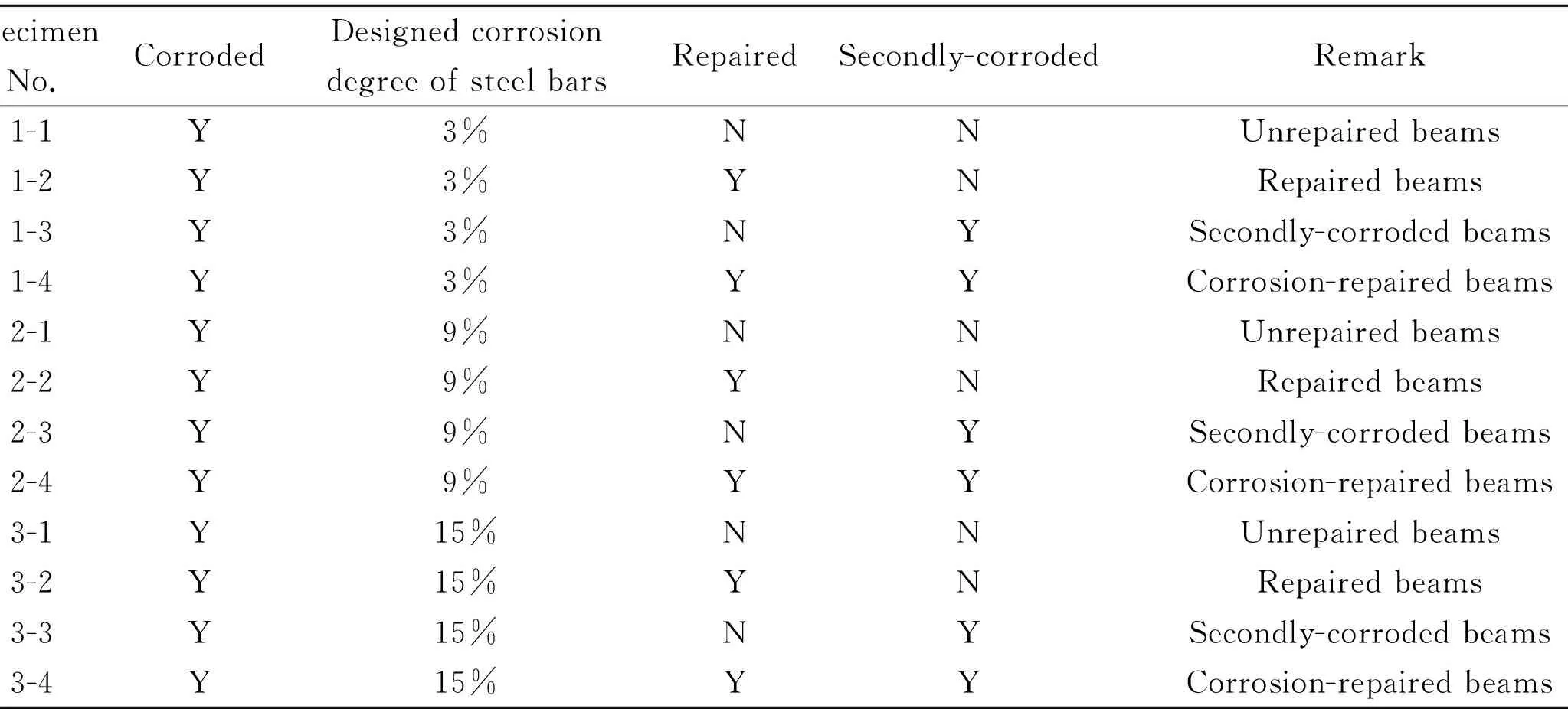
Table 1 Test matrix
1.1Specimens
All beams were 1 500 mm long with the same rectangular cross section dimension of 80 mm×160 mm. Coarse aggregates with the minimum size of 5 mm and the maximum size of 20 mm were used in the concrete mixture. The fine aggregates used were river sand, and the fineness modulus of the sand was 2.4. Ordinary Portland cement with a 28 d compressive strength of 42.5 MPa was used in the specimens. The tensile steels consist of two ribbed bars of 10 mm. Two plain bars with 6.5 mm were used for the compressive steels. The concrete was casted in laboratory with target strength of 30 MPa. The concrete mixture ratio is represented by cement: water: sand: gravel=4.26: 2.21: 8.6: 15.29. The dimensions and reinforcement details of test specimen are shown in Fig.1.

Fig.1 Dimensions and reinforcement details of test specimens
1.2Accelerated corrosion
After the 28-day maintenance of the test specimens, the longitudinal tensile bars of the specimens were corroded with constant current. The desired corrosion degree of steel bars was obtained by applying the anodic current for the time period calculated according to the Faraday′s law[7]. The corrosion of steel bars was accelerated by impressing an anodic current of 2 mA/cm2. The predicted and measured corrosion degrees of steel bars are showed in Table 2. It can be observed that the measured corrosion degrees of steel bars are very close to the predicted ones, which means the result is reasonable.

Table 2 Designed and measured corrosion degrees of steel bars
1.3Specimens reparation
When accelerating corrosion was completed, a 35 mm depth concrete from the bottom of the beam was removed using a concrete chisel and hammer. And the rust of steel bars was cleared up until the original color of the steel bars appeared. The dust was eliminated from the surface of the steel bars and concrete. The specimens were dried under the sun and the surface of the specimens must be kept dry. After that, the interface of concrete was covered with epoxy mixture. And the thickness is no more than 1 mm. Then the epoxy mortar was used to repair corroded beams and its ratio[8]is expressed by resin: ethylenediamine: dibutyl butylphosphonate: cement: sand=1.0: 0.16: 0.15: 2.0: 4.0. When daubing epoxy mortar, the thickness of epoxy mortar should be 10 mm at a time. Moreover, in order to bond firmly with the concrete surface, the epoxy mortar must be slapped more than once.
1.4Second-corrosion of repaired and unrepaired beams
Three repaired beam specimens and three unrepaired specimens were immersed in 3.5% NaCl solution in a tank for 35 days. The solution level was adjusted to 20 mm higher than the bottom of reinforced concrete (RC) beam specimens, so that only the tensile steel bars could be subjected to corrosion process. Secondly-corroded beam specimens are shown in Fig.2.

Fig.2 Beam specimens being secondly-corroded
1.5Loading test
After the specimens were subjected to second-corrosion, a loading test was performed. Loads were applied to four-point bending with a clear span of 1 200 mm. Loads and mid-span deflections were measured during loading. Fig.3 shows the loading test setup.
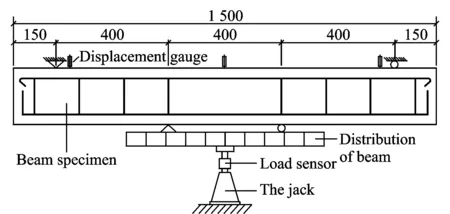
Fig.3 Setup of loading test
2 Results and Discussions
2.1Crack and failure patterns
Fig.4 shows the crack patterns of beam specimens, and the beam is placed upside down. For the secondly-corroded beam specimens, some flexural cracks developing upward from the bottom (tensile) side of the beams are terminated at the intersection of the horizontal cracks induced by corrosion. Furthermore, the flexural cracks of the unrepaired beam specimens propagated upward in the vertical direction along the stirrups.

Fig.4 Crack patterns of beam specimens
The crack pattern of corrosion-repaired beams was different from that of unrepaired beams. With load increasing, no more crack appeared after concrete cracking. The two cracks at load point propagated to be main cracks, wider and higher. After tensile steel bars yielded, load increased until concrete crushed. The beams failed. All beams in loading test were of bending failure pattern.
Fig.5 shows load and mid-span deflection curves of beam specimens in loading test. It can be seen from Fig.5(a) that the load-mid-span deflection curves of unrepaired beams and repaired beams were essentially coincident with the same slope when beams were in elastic stage and load was less than 10 kN. As load increasing and beams reaching an elastic-plastic stage, the slope of load-mid-span deflection curve of repaired beams was significantly greater than that of unrepaired beams, which means repaired beams exhibited larger stiffness. Finally, the bearing capacity of repaired beams was significantly higher than that of unrepaired beams with the same corrosion degree. Meanwhile, all of the beams demonstrated great ductility.
A similar conclusion could be drawn from Fig.5(b). The difference was the elastic limit load decreasing to 5 kN. When load increased to about 27 kN, secondly-corroded beam 3-3 with largest corrosion degree failed with poor deformability, from which the feature of brittle failure was showed to some extent.
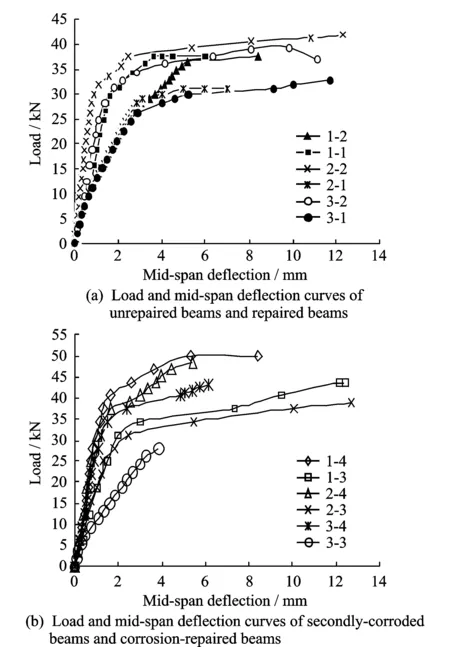
Fig.5 Load and mid-span deflection curves of beam specimens in load test
2.2Cracking load
Fig.6 shows the relationship between cracking loads of beam specimens and corrosion degrees of steel bars. During the uploading process, tensile zone of the specimens was monitored by the crack measurement tool. When the first bending crack appeared, the load was defined as the cracking load. It is found that cracking loads decrease with the increasing of corrosion degrees of steel bars in unrepaired beams and secondly-corroded beams. But there is not significant relationship between cracking loads and corrosion degrees in repaired beams and corrosion-repaired beams. It is obvious that cracking loads of repaired beams and corrosion-repaired beams are larger than that of unrepaired beams and secondly-corroded beams. It can be explained that concrete crack due to the corrosion expansion of steel bars leads to the decrease of section modulus of unrepaired beams and secondly-corroded beams. Instead, repaired with epoxy mortar, the section modulus of these repaired beams can be enhanced greatly. Furthermore, large tensile strength of epoxy mortar also plays an important role in the increase of cracking loads.
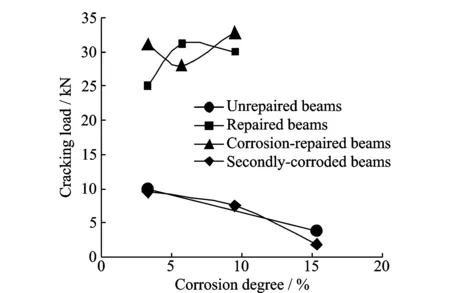
Fig.6 Cracking loads and corrosion degrees of steel bars
2.3Flexural capacity
Fig.7 shows flexural capacities of 12 RC beam specimens. It can be found that in unrepaired beams and secondly-corroded beams when corrosion degree of steel bars is smaller than 10%, flexural capacity changes little. Meanwhile, when corrosion degree exceeds 10%, flexural capacity decreases quickly. For repaired beams, corrosion degree has little effect on flexural capacity. There is a slight drop in flexural capacity when corrosion degree increases in corrosion-repaired beams. When the corrosion degrees are smaller than 10%, the flexural capacity of repaired beams is similar with that of unrepaired beams. When the corrosion degrees are larger than 10%, the bearing capacity of repaired beams is higher than that of unrepaired beams.
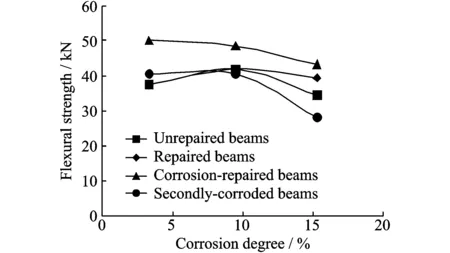
Fig.7 Flexural capacity of all beams 2.4 mid-span deflection and bending stiffness
It is worth mentioning that the flexural capacity of corrosion-repaired beams is larger than that of repaired beams. Since loading test on repaired beams was investigated only after 7 day′s curing, the loading test on corrosion-repaired beams was investigated after 7 day′s curing adding 35 day′s immersion in salt solution. Perhaps the immersion in salt solution for 35 days has no negative effect on the curing of cover repaired with epoxy mortar. Conversely, the tensile strength of epoxy mortar, together with the bond strength between repair materials and old concrete can be improved normally through more curing, which leads to a sharp increase in flexural capacity of corrosion-repaired beams, compared with repaired beams.
2.4Mid-span deflection and bending stiffness
The curves of mid-span deflections and corrosion degrees of 12 beam specimens are showed in Fig.8. It is found that corrosion degree has little influence on mid-span deflection for all beam specimens when load is small. When load increasing to a level, mid-span deflection of the beam specimens with high corrosion degree increases greatly, compared with that of the beam specimens with low corrosion degree. It can be explained that when load achieving to a level, the steel bars are easier to yield for the beam specimens with large corrosion, thus resulting in the stiffness decreasing as well as the deflection increasing.
As can be seen from Figs.8(a), (b),the mid-span deflection of repaired beams is smaller than that of unrepaired beams while corrosion degree and load level are same, which means the bending stiffness of repaired beams is larger than that of unrepaired beams. Similarly, from Figs.8(c), (d), it can be observed that at the same load level, with the same corrosion degree, the mid-span deflection of corrosion-repaired beams is smaller than that of secondly-corroded beams, which means the bending stiffness of corrosion-repaired beams is large, compared with that of secondly-corroded beams.
Here define the parameter, changing load, as a threshold above which the mid-span deflection of beam specimens will grow rapidly with corrosion degree increase. The changing load of unrepaired beams, repaired beams, secondly-corroded beams and corrosion-repaired beams are 25 kN, 31.25 kN, 6.25 kN and 37.55 kN, respectively. Thus, it is implied that both reparation and soak in salt solution for some time after reparation can enhance the changing load of beam specimens to a certain degree.
It is worth noting that the change trend of the relationship between mid-span deflection and corrosion degree in unrepaired beams, secondly-corroded beams and corrosion-repaired beams is different from that in repaired beams when the load exceeds changing load. In the former three sets of beam specimens, the curves of the relationship between mid-span deflection and corrosion degree are similar to the curve of exponential function with radix 2, which means the rate of increase of mid-span deflection of these beams is greater than that of corrosion degree. Meanwhile, from Fig.8(b), it can be found that mid-span deflection of repaired beams grows more and more slowly with corrosion degree increase when corrosion degree exceeds 10%. The curve of the relationship between mid-span deflection and corrosion degree in repaired beams is similar to the curve of logarithmic function with a radix e. It is implied that under heavier loads, the influence of the increase of corrosion degree on the loss of bending stiffness for repaired beams is a bit less than that for the other three kinds of beams, from which the reliability of repaired beams may be manifested from one side.
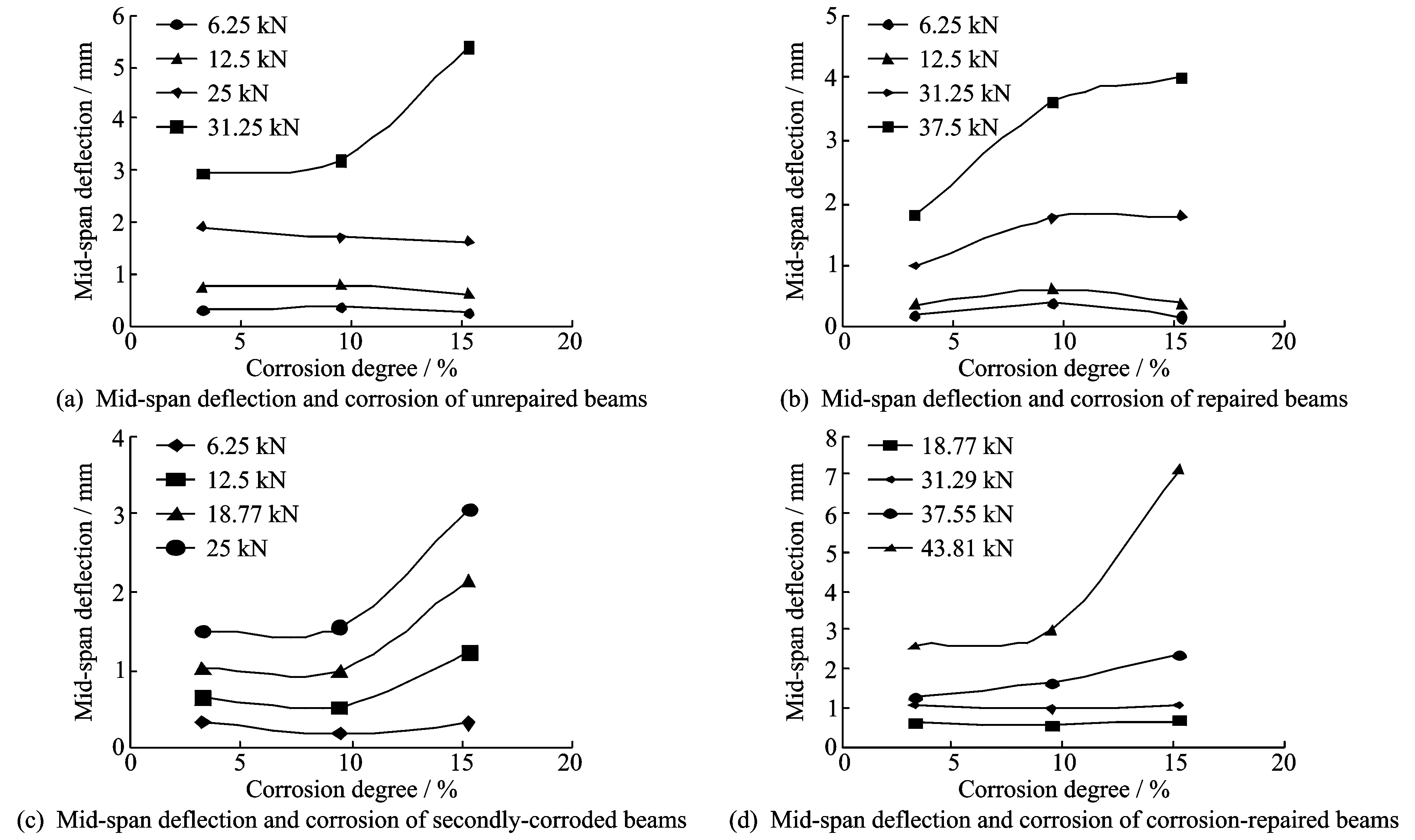
Fig.8 Mid-span deflection and corrosion of beams specimens
2.5Corrosion of corrosion-repaired beams
Corrosion-repaired beams did not crack during the phase of secondly-corrosion. Steel bars of corrosion-repaired beams have no rust spot, which indicates that epoxy mortar performs well in sealing and corrosion resistance.
3 Conclusions
The following conclusions can be drawn based on the experimental results.
Since the repair material, epoxy mortar, can maintain the section stiffness of beam specimens and provide large tensile strength for the specimens, the cracking loads of the repaired beams and the corrosion-repaired beams are larger than those of unrepaired beams and secondly-corroded beams with the same corrosion degree.
When the corrosion degrees are lower than 10%, the bearing capacity of the repaired beams is similar to that of the unrepaired beams. When the corrosion degrees are larger than 10%, the bearing capacity of the repaired beams is higher than that of the unrepaired beams.
Corrosion degree has little influence on mid-span deflection for all beams when the load is small. When the load increases to a certain level, mid-span deflection of the beam specimens with high corrosion degree increases significantly, compared with that of the beam specimens with a low corrosion degree. The bending stiffness of the repaired beams is larger than that of the unrepaired beams, and meanwhile the bending stiffness of the corrosion-repaired beams is larger than that of the secondly-corroded beams.
The curves depicting the relationships between mid-span deflection and corrosion degree of the unrepaired beams, secondly-corroded beams and corrosion-repaired beams are similar to the curve of exponential function with a radix of 2, while the curve of the relationship between mid-span deflection and corrosion degree in the repaired beams is similar to the curve of logarithmic function with a radix of e.
Steel bars of the corrosion-repaired beams survive the corrosion in salt solution, benefiting from great density of epoxy mortar.
Acknowledgements
This work was supported by the National Natural Science Foundation of China (No.51279074), and the Project Funded by the Priority Academic Program Development of Jiangsu Higher Education Institutions.
[1]FAN Yunchang, CAO Xingguo, CHEN Huairong. Protection and repair of corroded reinforced concrete[M].Beijing: China Railway Publishing House,2001:8-15. (in Chinese)
[2]RíO O, ANDRADE C, IZQUIERDO D, et al. Behavior of patch-repaired concrete structural elements under increasing static loads to flexural failure[J].Journal of Materials in Civil Engineering, 2005,17(2):168-177.
[3]AL-DULAIJAN S U, AL-ZAHRANI M M, SARICIMEN H, et al. Effect of steel bars cleanliness and repair materials on reinforcement corrosion and flexural strength of repaired concrete beams[J]. Cement and Concrete Composites,2002,24:139-149.
[4]RAUPACH M. Patch repairs on reinforced concrete structures: Model investigations on the required size and practical consequences[J]. Cement & Concrete Composites, 2006(28):679-684.
[5]RIBEIRO J L S, PANOSSIAN Z, SELMO S M S, et al. Proposed criterion to assess the electrochemical behavior of carbon steel reinforcements under corrosion in carbonated concrete structures after patch repairs[J]. Construction and Building Materials,2013(40):40-49.
[6]MORADI-MARANI F. Investigation of corrosion damage and repair system in a concrete jetty structure[J]. Journal of Composites for Construction,2010,24(4):294-301.
[7]JI Yongsheng, YUAN Yingshu, BEI Dou. Experimental research on electrochemical incompatibility of local repair of corroded reinforced concrete[J].Concrete,2004(6):3-6. (in Chinese)
[8]LI Hongming, WU Jin, WANG Zhe, et al. Performance of epoxy-repaired corroded reinforced concrete beams[J]. Trans Nanjing Univ Aero Astro, 2015, 36(5):579-584.
Dr. Wu Jin is a professor and doctoral supervisor in Nanjing University of Aeronautics and Astronautics (NUAA). He received his Ph.D. degree in Hohai University in 2003. His research interest focuses on the durability of concrete structure.
Ms. Tang Jinzhi is a Ph.D. candidate in NUAA. She received her M.Sc. degree from Jiling University in 2009. Her research interest is durability of concrete structure.
Mr. Li Hongming is an assistant engineer. He received his M.Sc. degree from NUAA in 2015. His research interest is durability of concrete structure.
Mr. Shang Baokang is an assistant engineer. He received his M.Sc. degree from NUAA in 2014. His research interest lies in durability of concrete structure.
Dr. Wang Zhe is an associate professor of NUAA. She received her Ph.D. from Nanyang Technological University in 2005. Her research interest is concrete structure.
(Executive Editor: Zhang Tong)
, E-mail address: wujin@nuaa.edu.cn.
How to cite this article: Wu Jin, Tang Jinzhi, Li Hongming, et al. Behavior of corrosion-repaired concrete beams reinforced by epoxy mortar[J]. Trans. Nanjing Univ. Aero. Astro., 2016,33(3):395-402.
http://dx.doi.org/10.16356/j.1005-1120.2016.03.395
TU37Document code:AArticle ID:1005-1120(2016)03-0395-08
杂志排行
Transactions of Nanjing University of Aeronautics and Astronautics的其它文章
- Model Updating for High Speed Aircraft in Thermal Environment Using Adaptive Weighted-Sum Methods
- Stiffness Distribution and Aeroelastic Performance Optimization of High-Aspect-Ratio Wings
- DNS Study on Volume Vorticity Increase inBoundary Layer Transition
- Numerical Calculations of Aerodynamic and Acoustic Characteristicsfor Scissor Tail-Rotor in Forward Flight
- Removing Random-Valued Impulse Noises by a Two-Staged Nonlinear Filtering Method
- Robust Fault-Tolerant Control for Longitudinal Dynamics of Aircraft with Input Saturation
